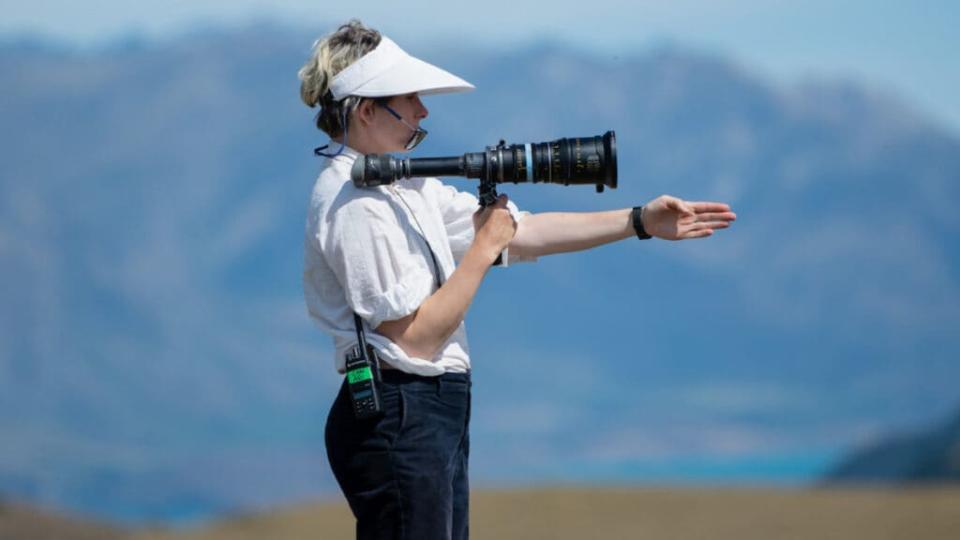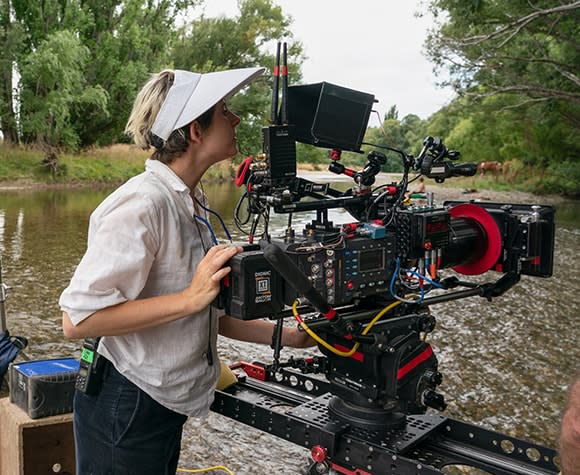Why Cinematography Is Oscars’ Biggest Boys Club, With Only 2 Female Nominees in 94 Years
- Oops!Something went wrong.Please try again later.
- Oops!Something went wrong.Please try again later.
- Oops!Something went wrong.Please try again later.
- Oops!Something went wrong.Please try again later.
In the 94-year history of the Oscars, there is only one category, besides Best Actor and Best Supporting Actor, that has never been won by a woman. That would be Best Cinematography, which honors a movie’s lighting, framing and camerawork.
Those are hardly gender-specific achievements, though the Oscars, for better or worse, are a reflection of the opportunities offered in the film industry. And as such, there are deep institutional reasons why this specific category has such a poor track record for women.
The trivia stat could change on Sunday night. Ari Wegner, the Australian cinematographer of Jane Campion’s nomination-leader “The Power of the Dog,” is nominated for her thoughtful, intuitive work on the film. TheWrap’s Steve Pond predicts that Wegner will take home the trophy, giving her the edge over “Dune” DP Greig Fraser (the cinematographer of Campion’s previous movie “Bright Star”), who has scored the BAFTA and ASC precursors. But Wegner’s nomination alone still marks a milestone.

She joined Rachel Morrison (who photographed 2017’s “Mudbound”) as the only women ever nominated in the category. That’s two out of more than 500 cinematography nominees since the first Oscars in 1929. And this particular award, in fact, has even had more people nominated than other branches of the Academy, because from the 1930s to the 60s, there were two category lineups to distinguish between color and black-and-white movies.
The lack of gender parity in the film industry is not surprising. After all, even with an aggressive membership drive by the Academy in recent years, the voting body is still two-thirds men, 68 percent to 32 percent. But why specifically is Best Cinematography, and by extension the art of cinematography, such an exclusive men’s club? A glance at female representation in other technical Oscar categories reveals a trail of clues.
Take Best Costume Design, Oscar’s most generous category for female nominees. At least one woman has been nominated every year since the category was inaugurated in 1948, with about a 50 percent winning ratio, including nine of the last 10 winners. The most awarded woman in Oscar history is a costume designer, Edith Head.
Best Film Editing has also been somewhat less of a male fraternity. Like costume design, the craft emerged from the skills of sewing and stitching. Women film editors have been nominated 81 times, starting when the award was created in 1934, and the 15 movies edited by women that have won the Oscar include classics such as “Laurence of Arabia” (Anne V. Coates), “Jaws” (Verna Fields), “Star Wars” (co-edited by Marcia Lucas), “Raging Bull” (Thelma Schoonmaker), “Platoon” (Claire Simpson), and “Mad Max: Fury Road” (Margaret Sixel).
But the presence of women in editing is useful in explaining why there has been such a dearth of women in cinematography. In the early decades of Hollywood, cutting film was a lower-wage, menial job, and easier for women to enter into and ascend to positions of department head. Dorothy Arzner, practically the only woman director in the first four decades of Hollywood moviemaking, came from a film editing background during the silent era.
Cinematography is a different animal. On a movie set’s call sheet, the director of photography’s name is listed right below the director’s. The cinematographer is often the highest-salaried member of the technical crew. On a movie’s clapperboard, the only two names listed are the director and the cinematographer. The relationship between the two is both intimate and very public-facing, in terms of how it’s perceived by the crew.
There’s a theory that women have been excluded from cinematography for so long because of the challenges of lifting heavy camera equipment. Which might be partially true, but reads more like a convenient excuse than a valid explanation – especially given that many male cinematographers of the classic era were hardly in peak physical condition. (A fact, incidentally, that’s still very true today.)
It’s more plausible that decades of male directors simply lacked the wherewithal to collaborate in such a susceptible way with a woman. Iconic director Cecil B. DeMille, for example, was comfortable in his professional, albeit behind-closed-doors, collaboration with film editor Anne Bauchens, who cut and shaped 43 of his films, including “Cleopatra” and “The Ten Commandments.” DeMille even included a clause in his film contracts that no one other than Bauchens could edit his movies, though it goes without saying that no such “inclusion rider” existed for his cinematographer.
Though the history of still photography is brightened by women like Margaret Bourke-White, Vivian Maier and Dorothea Lange, cinematography was classified early on as technical practice rather than an artistic one. Motion pictures themselves were considered visual effects, and thus drew much more from male-dominated fields such as engineering rather than photography. Interestingly, the Oscar category with the worst gender parity after Best Cinematography is Best Visual Effects, with only four women ever nominated.
And to be sure, like all self-reinforcing feedback loops, women cinematographers didn’t exist because… women cinematographers didn’t exist. Just as the scarcity of female airline pilots has nothing to do with a female’s ability to fly a plane, women for decades were excluded from the field of the cinematography based on the wobbly premise that they didn’t have enough proven experience.
It took decades and decades before a woman was even hired as cinematographer for a Hollywood film. And when it happened, an Oscar-winning actress was responsible for breaking the gender barrier. In 1980, Anne Bancroft (“The Miracle Worker,” “The Graduate”) made her sole directorial effort with the tragicomedy “Fatso,” starring Dom DeLuise. Bancroft hired Brianne Murphy, a script supervisor with a passion for camerawork, as her cinematographer.
The film was not a success, but Murphy was invited to join the American Society of Cinematographers Guild the following year, and in 1982 she was awarded a special Oscar plaque for helping with the invention of a vehicle to provide more safety features for cinematographers while filming moving cars. But though she continued working as a cinematographer on television, earning three Emmy nominations, Murphy died in 2003 having never shot another major studio film.
Yet slowly, more female cinematographers began to emerge from the realm of low-budget, experimental and art-house cinema. Ellen Kuras shot Tom Kalin’s “Swoon,” Mary Harron’s “I Shot Andy Warhol,” and Spike Lee’s “Summer of Sam.” Maryse Alberti was the DP on Todd Haynes’s “Poison” and “Velvet Goldmine,” Darren Aronofsky’s “The Wrestler,” and Ryan Coogler’s “Creed.” Lisa Rinzler shot “Menace II Society” and “Pollock.” Charlotte Bruus Christensen lensed “Fences” and “A Quiet Place.”
In Europe, especially in France, women DPs have included Agnès Godard (“Beau Travail”), Claire Mathon (“Portrait of a Lady on Fire”), and Hélène Louvart (who last year shot Maggie Gyllenhaal’s “The Lost Daughter”).
When Rachel Morrison scored a historic Oscar nomination for “Mudbound” in 2018, she also that year became the first woman to photograph a major superhero movie, when she shot Coogler’s “Black Panther.” Mandy Walker followed with Niki Caro’s 2020 “Mulan,” and Walker could certainly be a contender at next year’s Oscars with her work on Baz Lurhmann’s musical biopic “Elvis.”
The ratio of women lensers in feature films remains well below 10 percent, but it’s slightly better in television. Reed Moreno (“Looking,” “Vinyl”) is a prolific cinematographer, who has made the leap into directing, winning an Emmy for the pilot of “The Handmaid’s Tale.” Television was also the venue where cinematographer Halyna Hutchins (“A Luv Tale”) honed her craft before her tragic death last October on the New Mexico set of the Western “Rust.”
Gradually, the landscape is changing. Jane Campion’s four-decade career is notable for sumptuous visual collaborations with cinematographers like Stuart Dryburgh (“The Piano”) and Dion Beebe (“Holy Smoke”), but Campion was deliberate in hiring Ari Wegner for “The Power of the Dog,” sensing that the male-dominated story required another pair of woman’s eyes.

It marks Campion’s first film with a woman as her DP. In fact, of the seven women nominated for the Best Director Oscar – Lina Wertmüller, Campion, Sofia Coppola, Kathryn Bigelow, Greta Gerwig, Emerald Fennell and Chloe Zhao – Campion is the first to work with a female cinematographer on a feature film. Which, of course, is not a critique of those other filmmakers but an illustration of the challenges that women all over the film industry still face.
And all the more reason why Wegner’s nomination should be celebrated, in part because it represents that Morrison’s nod four years ago wasn’t a historical blip. But if Wegner wins the Oscar, it will be because of the profound visual sweep and gorgeous macro-closeups in “The Power of the Dog.” (Morrison recently interviewed Wegner and during their 36-minute conversation, the two craftmasters spoke of their work without once mentioning gender.)
But the Oscar are a fair representation of opportunities. According to Wegner, who’s only in her mid-30s and was hotly sought-after even before her nomination (her other credits include “Lady Macbeth” and “Zola”), this whole experience is all about the work itself.
“When a cinematographer crosses paths with Jane Campion, their life changes,” Wegner told TheWrap. “It was incredibly thrilling and such an honor that she thought of me as someone that could take on this film. And she’s got a really good sense of loyalty with her crew. I mean, if Jane doesn’t work with someone a second time, there were probably some circumstances to do with that. I’m hoping to work with her a lot more in both of our careers. She’s a dream director.”

Wegner pushed back a bit when asked specifically about her role as a woman cinematographer. She smiles and laughs a lot while talking about her work, and did so as well when asked about the best part of her job.
“It’s just the sheer joy and the pleasure that comes from looking at something closer and deeper than the eye can naturally see,” she said. “That my favorite thing about what I do and my favorite thing about cinema. You have the opportunity to see things in a way that the eye can’t see – specifically things that big, that close, that important.”

